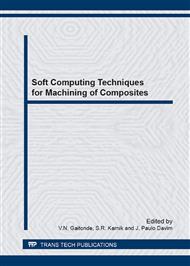[1]
Y.M. Quan, Z.H. Zhou, B.Y.Ye, Cutting and chip appearance of aluminium matrix composites reinforced by SiC particle, Journals of Materials Processing Technology, 91 (1999) 231-235.
DOI: 10.1016/s0924-0136(98)00444-0
Google Scholar
[2]
T.Ozben, Erol Kilickap, OrhanCakir, Investigation of mechanical and machinability properties of SiC particle reinforced Al-MMC, Journals of Materials Processing Technology, 198 (2008) 220 - 225.
DOI: 10.1016/j.jmatprotec.2007.06.082
Google Scholar
[3]
A.Manna, B. Bhattacharayya, A study on machinability of Al /SiC – MMC, Journals of Materials Processing Technology, 140 (2003) 711-716.
DOI: 10.1016/s0924-0136(03)00905-1
Google Scholar
[4]
J.P. Davim, Design of optimisation of cutting parameters for turning metal matrix composites based on the orthogonal arrays, Journals of Materials Processing Technology, 132 (2003) 340-344.
DOI: 10.1016/s0924-0136(02)00946-9
Google Scholar
[5]
C.S. Liu, B.Zhao, G.F. Gao, F.Jiao, Research on the characteristics of the cutting force in the vibration cutting of a particle reinforced metal matrix composites SiCp/Al, Journal of Materials Processing Technology, 129(1-3) (2002) 196 - 199.
DOI: 10.1016/s0924-0136(02)00649-0
Google Scholar
[6]
N.Muthukrishnan, J.P. Davim, Optimization of machining parameters of Al/SiC-MMC with ANOVA and ANN analysis, Journal of Materials Processing Technology, 209 (2009) 225 - 232.
DOI: 10.1016/j.jmatprotec.2008.01.041
Google Scholar
[7]
M.Seeman, G.Ganesan, R.Karthikeyan, A.Velayudham, Study on tool wear and surface roughness in machining of particulate aluminum metal matrix composite-response surface methodology approach, International Journal of Advanced Manufacturing Technology, 48 (2010) 613 - 624.
DOI: 10.1007/s00170-009-2297-z
Google Scholar
[8]
Y.F.Ge, J.H.Xu, H.Yang, S.B. Luo, Y.C.Fu, Workpiece surface quality when ultra-precision turning of SiCp/Al composites, Journals of Materials Processing Technology, 203 (2008) 166-175.
DOI: 10.1016/j.jmatprotec.2007.09.070
Google Scholar
[9]
S.N. Reddy, Shin Kwang-Sup, M.Yang, Experimental study of surface integrity during end milling of Al/SiC particulate metal–matrix composites, Journals of Materials Processing Technology, 201 (2008) 574 - 579.
DOI: 10.1016/j.jmatprotec.2007.11.280
Google Scholar
[10]
S.M. Karakas, AdemAcir, Mustafa Ubeyli, Bilgehan Ogel, Effect of cutting speed on tool performance in milling of B4Cp reinforced aluminum metal matrix composites, Journals of Materials Processing Technology, 178 (2006) 241-246.
DOI: 10.1016/j.jmatprotec.2006.04.005
Google Scholar
[11]
H.Oktema, T.Erzurumlu, H.Kurtaran, Application of response surface methodology in the optimization of cutting conditions for surface roughness, Journals of Materials Processing Technology, 170 (2005) 11 - 16.
DOI: 10.1016/j.jmatprotec.2005.04.096
Google Scholar
[12]
J.T. Lin, D.Bhattacharyya, W.G. Fergusod, Chip Formation in the machining of SiC – Particle Reinforced Aluminium – Matrix Composites, Composites Science and Technology, 58 (1998) 285- 291.
DOI: 10.1016/s0266-3538(97)00126-7
Google Scholar
[13]
R.S. Pawade, Suhas S Joshi, P.K. Brahmankar, M,Rahman, An investigation of cutting forces and surface damage in high-speed turning of Inconel 718, Journal of Materials Processing Technology, 192-193, (2007) 139-146.
DOI: 10.1016/j.jmatprotec.2007.04.049
Google Scholar
[14]
R.Arokiadass, K.Palaniradja, N.Alagumoorthi, Predictive modeling of surface roughness in end milling of Al/SiCp metal matrix composite, Archives of Applied Science Research, 3(2011) 228– 236.
DOI: 10.4314/ijest.v3i6.7
Google Scholar
[15]
R.Teti, Machining of Composite Materials, CIRP Annals– Manufacturing Technology, 51(2) (2002) 611 - 634.
DOI: 10.1016/s0007-8506(07)61703-x
Google Scholar
[16]
Uday A. Dabade, Suhas S.Joshi, Analysis of chip formation mechanism in machining of Al/SiCp metal matrix composites, Journal of Materials Processing Technology, 209 (2009) 4704 – 4710.
DOI: 10.1016/j.jmatprotec.2008.10.057
Google Scholar
[17]
Davim JP (Ed) (2011), Machining of hard metals, Springer.
Google Scholar


